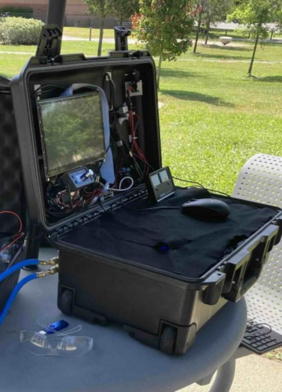Home > Press > Portable Raman analyzer detects hydrogen leaks from a distance: Device senses tiny concentration changes of hydrogen in ambient air, offering a dependable way to detect and locate leaks in pipelines and industrial systems
 |
| A new portable Raman analyzer can remotely measure very low concentrations of hydrogen gas in ambient air, even in outdoor environments. The new instrument could be useful for detecting small hydrogen leaks or geological sources.
Credit Andreas Muller, University of South Florida |
Abstract:
Researchers have developed a new portable Raman analyzer that can accurately measure very low concentrations of hydrogen gas in ambient air. The instrument could be useful for detecting hydrogen leaks, which pose serious safety risks due to the gass flammability and tendency to accumulate in confined spaces.
Portable Raman analyzer detects hydrogen leaks from a distance: Device senses tiny concentration changes of hydrogen in ambient air, offering a dependable way to detect and locate leaks in pipelines and industrial systems
Washington, DC | Posted on April 25th, 2025
As hydrogen gains recognition as a promising fuel for transportation, heating and power generation, ensuring safety and minimizing losses becomes even more crucial, said research team leader Andreas Muller of the University of South Florida. Hydrogen can leak through minute cracks in pipelines or storage tanks, and in industrial settings, detecting these leaks often requires approaching the source closely. Our Raman analyzer can sense small changes to the ambient hydrogen concentration to identify a leak from a distance.
In the Optica Publishing Group journal Applied Optics, the researchers showed that the instrument can, in a matter of minutes, detect hydrogen concentrations well below 1 part per million in ambient air and thus identify a leak of a few hundred milliliters per minute from a source several meters away.
Our versatile instruments could be useful in a variety of industrial and scientific applications, including exploration of the significant hydrogen resources that exist beneath the Earth’s surface, said Muller. The system could also be optimized to detect many other analytes at equally low concentrations, which might be useful for medical applications, for example.
Portable trace gas detection
Measuring very low concentrations of hydrogen gas in ambient air is difficult because hydrogen is a lightweight, colorless and odorless gas that can quickly disperse. Additionally, the sensitivity and precision of the detection method must be extremely high to pick up trace amounts without interference from background gases. Todays portable hydrogen sensors tend to rely on indirect electrochemical or electromechanical changes in chemically labeled surfaces and cant measure very low concentrations accurately.
To overcome these limitations, the researchers developed a new portable instrument based on Raman scattering, a technique that uses light to produce unique optical signals from a material, enabling non-invasive identification and measurement of substances. Although Raman scattering is used commercially to analyze liquids and solids, applying it for the detection of low concentrations of gas requires a way to enhance the Raman scattering signal, which is typically difficult to implement outside the laboratory.
In the new work, the researchers designed a Raman analyzer that uses multipass cavity enhancement, a type of enhancement that is uniquely forgiving of disturbances and does not require specialized lasers or stabilization techniques to function.
We previously studied Raman trace gas analyzers in the laboratory, but implementing a portable version required several engineering innovations, said Muller. Our new Raman analyzer can handle outdoor environments and map out minute hydrogen concentration changes around a source with reasonable form factor and power consumption.
Taking Raman analysis outside
To build the portable Raman gas analyzer, the researchers used a laser emitting at 442-nm with a high output power of several watts and a narrow linewidth of less than 0.1 nm. They also created a multipass cavity that didnt experience misalignment due to temperature changes in the environment. Crucially, the laser and spectrometer had to consume less than 10 watts each for sufficient field autonomy.
Charuka Arachchige, graduate student at the University of South Florida, led the effort of evaluating the stability and adaptability of the instrument across various environments by mapping hydrogen concentrations over time and distance from a hydrogen source. After the build-up and decay of hydrogen within a laboratory setting was characterized, he measured it as a function of distance, starting from 8 meters away from the source, across three different locations a laboratory room, an atrium, and an outdoor open space under various environmental conditions to assess the instruments sensitivity and stability.
The findings demonstrated consistent variations in hydrogen concentration across all locations, influenced by the prevailing environmental factors. They were also able to detect hydrogen levels just 63 parts per billion higher than the surrounding level from several meters away, even in outdoor conditions. This demonstrated that small leaks could be detected from a distance.
The researchers are continuing to improve the instruments limit of detection, speed of recording and compactness.
####
About Optica
Optica Publishing Group is a division of the society, Optica, Advancing Optics and Photonics Worldwide. It publishes the largest collection of peer-reviewed and most-cited content in optics and photonics, including 18 prestigious journals, the societys flagship member magazine, and papers and videos from more than 835 conferences. With over 400,000 journal articles, conference papers and videos to search, discover and access, our publications portfolio represents the full range of research in the field from around the globe.
About Applied Optics
Applied Optics publishes in-depth peer-reviewed content about applications-centered research in optics. These articles cover research in optical technology, photonics, lasers, information processing, sensing, and environmental optics. Optica Publishing Group publishes Applied Optics three times per month and oversees Editor-in-Chief Gisele Bennett, MEPSS LLC. For more information, visit Applied Optics.
For more information, please click here
Contacts:
Media Contacts
Sammi Bradley
Optica
Media Relations
Optica
Copyright © Optica
If you have a comment, please Contact us.
Issuers of news releases, not 7th Wave, Inc. or Nanotechnology Now, are solely responsible for the accuracy of the content.
News and information
![]()
Enhancing power factor of p- and n-type single-walled carbon nanotubes April 25th, 2025
![]()
Tumor microenvironment dynamics: the regulatory influence of long non-coding RNAs April 25th, 2025
![]()
Ultrafast plasmon-enhanced magnetic bit switching at the nanoscale April 25th, 2025
![]()
Next-generation drug delivery innovation! DGIST develops precision therapeutics using exosomes April 25th, 2025
Possible Futures
![]()
Lattice-driven charge density wave fluctuations far above the transition temperature in Kagome superconductor April 25th, 2025
![]()
Enhancing power factor of p- and n-type single-walled carbon nanotubes April 25th, 2025
![]()
Tumor microenvironment dynamics: the regulatory influence of long non-coding RNAs April 25th, 2025
![]()
Ultrafast plasmon-enhanced magnetic bit switching at the nanoscale April 25th, 2025
Discoveries
![]()
Lattice-driven charge density wave fluctuations far above the transition temperature in Kagome superconductor April 25th, 2025
![]()
HKU physicists uncover hidden order in the quantum world through deconfined quantum critical points April 25th, 2025
![]()
Nanophotonic platform boosts efficiency of nonlinear-optical quantum teleportation April 25th, 2025
Announcements
![]()
Enhancing power factor of p- and n-type single-walled carbon nanotubes April 25th, 2025
![]()
Tumor microenvironment dynamics: the regulatory influence of long non-coding RNAs April 25th, 2025
![]()
Ultrafast plasmon-enhanced magnetic bit switching at the nanoscale April 25th, 2025
![]()
Next-generation drug delivery innovation! DGIST develops precision therapeutics using exosomes April 25th, 2025
Interviews/Book Reviews/Essays/Reports/Podcasts/Journals/White papers/Posters
![]()
Nanophotonic platform boosts efficiency of nonlinear-optical quantum teleportation April 25th, 2025
![]()
Enhancing power factor of p- and n-type single-walled carbon nanotubes April 25th, 2025
![]()
Tumor microenvironment dynamics: the regulatory influence of long non-coding RNAs April 25th, 2025
Tools
![]()
Rice researchers harness gravity to create low-cost device for rapid cell analysis February 28th, 2025
![]()
New 2D multifractal tools delve into Pollock’s expressionism January 17th, 2025
![]()
Turning up the signal November 8th, 2024
Energy
![]()
KAIST researchers introduce new and improved, next-generation perovskite solar cell November 8th, 2024
![]()
Unveiling the power of hot carriers in plasmonic nanostructures August 16th, 2024
![]()
Groundbreaking precision in single-molecule optoelectronics August 16th, 2024
![]()
Development of zinc oxide nanopagoda array photoelectrode: photoelectrochemical water-splitting hydrogen production January 12th, 2024
Automotive/Transportation
![]()
Leading the charge to better batteries February 28th, 2025
![]()
Researchers approach may protect quantum computers from attacks March 8th, 2024










